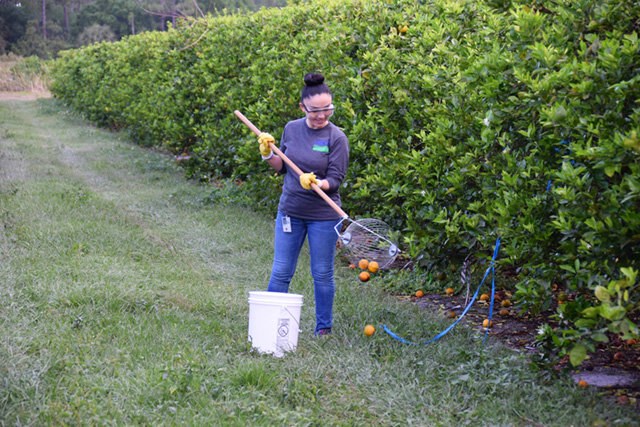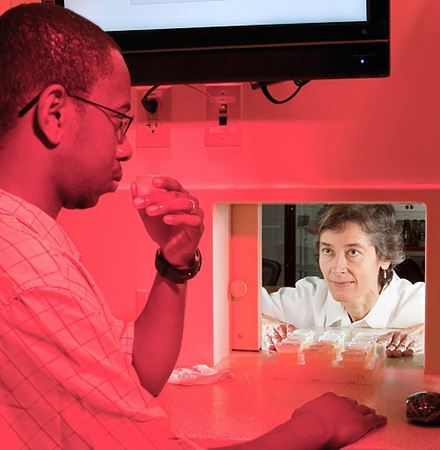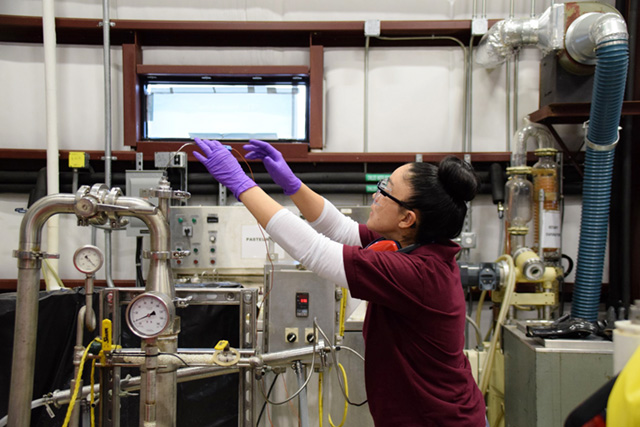
Finding Creative Solutions to Fight Food Waste and Loss
|
Christina Dorado is a research chemist and Anne Plotto is a research plant physiologist in the Citrus & Other Subtropical Products Unit at the U.S. Horticultural Research Laboratory in Fort Pierce, FL. Christina Dorado's work is focused on investigating value-adding technologies for Florida's major fruit crop, citrus. She researches methods for taking the peel, membrane, and seed and extracting valuable components or converting them into a more valuable product for consumers. Anne Plotto's research projects include flavor and off flavor in orange juice from HLB affected trees; quality evaluation of citrus, strawberries and blueberries from the USDA-ARS and University of Florida breeding programs and development of storage techniques for whole and fresh-cut fruit to optimize storage and quality. |
Welcome, Drs. Dorado and Plotto to Under the Microscope.
UM: Why is food waste and food loss a problem?
CD: Both food waste and food loss impact society, the environment, and our economy. When food is lost to waste, all inputs used to create that food are also lost, an economic impact. There are also environmental impacts from food production, particularly animal products such as meat and dairy. In addition to those impacts, wasted food ends up in a landfill and is broken down by microorganisms. This process produces greenhouse gases and other chemicals that end up in our land and water, worsening the environmental impact. Finally, food that is lost to waste could have been used to feed those who are hungry and in need of food, meaning there is a humanitarian cost to society as well.
UM: How much food loss and waste is there in the U.S., and why?
CD: In the U.S., 30-40 percent of food is wasted. Globally, approximately 14 percent of the world's food, valued at $400 billion, is lost on an annual basis between harvest and the retail market. At the same time, an estimated 17 percent of food is wasted at the retail and consumer levels. The reasons vary among regions of the world, based on the food type and the stage in the supply chain. Generally, food loss and waste can be attributed to spoilage, damage, over-production, over-purchasing, over-preparing, and unappealing sensory attributes (i.e., appearance).
 ARS research chemist Christina Dorado collecting dropped fruit at Picos Farm for investigation of volatile collection using steam explosion. (Photo courtesy of Christina Dorado)
ARS research chemist Christina Dorado collecting dropped fruit at Picos Farm for investigation of volatile collection using steam explosion. (Photo courtesy of Christina Dorado)
UM: How does your research address food waste and loss?
CD: Our goal is to reduce food waste from agricultural production by finding ways to convert this waste into valuable products. Specifically, my work is focused on investigating value-adding technologies for the major fruit crop in the state of Florida, citrus. Oranges make up the majority of citrus fruit grown in Florida, and 95% of that crop is processed into juice. About half of an orange is juice, while the other half is made up of the peel, membrane, and seeds. Currently, the peel, membrane, and seeds are converted to animal feed, a low-value product, or are disposed of in landfills. I research methods for taking the peel, membrane, and seed and extracting valuable components or converting them into a more valuable product for consumers.
AP: My team works on extending the post-harvest life of fresh produce, mainly fruit, and maintaining the quality of fresh and processed whole and fresh-cut fruits. Consumers do not like to buy fruit that spoils right away. Dr. Bai developed a clamshell for small fruit (strawberries, blueberries, lychee, etc.) that preserves moisture, and therefore reduces water loss during storage. He also added some natural antimicrobials that delay the development of decay. We are currently seeking funding to develop active packaging for fresh fruit. We are using slow-release thyme or oregano essential oils (mainly thymol or carvacrol, the active ingredients in thyme and oregano, respectively) in clamshells to delay postharvest decay.
UM: How does increasing the appeal of produce in the marketplace reduce food loss?
AP: Consumers tend to repeatedly purchase products that they enjoy eating. I work closely with the strawberry breeders from University of Florida to select fruit varieties that have consistent flavor, with high sweetness and strawberry flavor. The breeder needs an independent panel of tasters, and we provide that know-how. We also work closely with the citrus breeder to select varieties that will provide a good juice. With citrus, it is more complicated, because for a tree, it takes longer (9-15 years) to produce a crop.
 ARS research plant physiologist Anne Plotto serves orange juice samples as part of her research on consumers' sensory response to the beverage. (Photo by Steve Ausmus, D2706-5).
ARS research plant physiologist Anne Plotto serves orange juice samples as part of her research on consumers' sensory response to the beverage. (Photo by Steve Ausmus, D2706-5).
UM: What other uses for fruit byproducts are researchers exploring?
CD: A couple of major products that can be extracted from citrus peel, membrane, and seed are peel oil, pectin, and bioflavonoids. Peel oil is used in the fragrance and flavor industry and is recognized as a "green" solvent. Pectin is used in food to modify texture, and bioflavonoids are used in nutraceuticals for their health promoting properties. Currently, we are investigating steam-treated peel for use as a non-gluten food fiber.
UM: Could solutions you develop in one area potentially be applied to other foods as well? For instance, could applications for citrus also be used for other kinds of produce?
CD: Yes. This is especially true if the methods for food production are similar and the components to be extracted or products developed are similar.
UM: What challenges have arisen in the course of your research?
 ARS research chemist Christina Dorado connecting thermocouple to steam explosion system to investigate volatile collection from dropped fruit. (Photo courtesy of Christina Dorado)
ARS research chemist Christina Dorado connecting thermocouple to steam explosion system to investigate volatile collection from dropped fruit. (Photo courtesy of Christina Dorado)
CD: Citrus greening disease has reduced citrus production in the state of Florida by over 70% since 2005. Value-added products can offset the losses by ensuring that the whole fruit is converted to valuable products.
AP: Citrus greening has significantly affected not only production quantity, but fruit that remain on the trees produce juice that is of lower quality. Our research has identified the components of low quality (lower sweetness, increased sourness and bitterness), and we have worked with industry collaborators to find solutions to maintain orange juice quality.
We are also working closely with the ARS citrus breeders. When a tree is identified as tolerant to the disease in the field, we analyze the fruit to assess its quality, whether it would be acceptable to consumers. The challenge is that fruit quality is highly influenced by the disease status of the tree, and weather conditions. So, we need several years of data. Recently, we have identified some varieties (oranges or mandarins) that may be good candidates for release. Hurricanes are also a big challenge, because they not only impact a crop when they happen, but they also cause stress to the trees, which affects production in the following year.
UM: Why is reducing food loss and waste such a challenge?
CD: There is not one single solution to addressing food loss and waste. Because food loss and waste occur at various steps in the food supply chain and are dependent on the food type and region, we have to address specific issues associated with the individual parts of the food supply chain, food type, and region.
However, we should not feel as if we cannot contribute to the solution because of the size of the problem. As consumers, we have a great deal of power in how we consume food. By changing how we purchase, prepare, and consume food in our homes and restaurants, we can make a difference.
To learn more about how to reduce food waste in your own life, check out USDA's Food Loss and Waste page.
